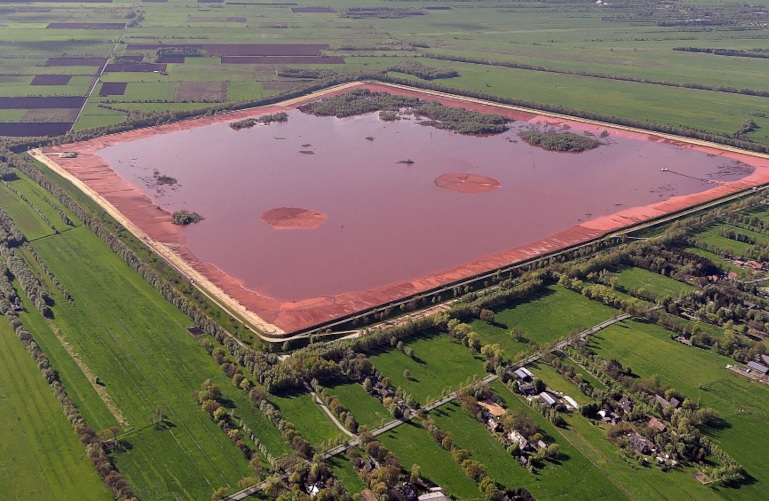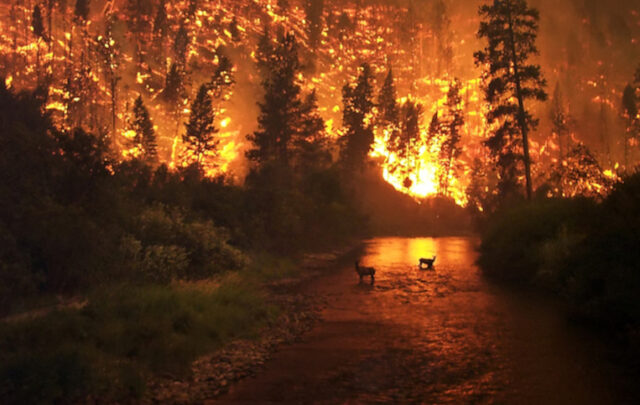This is the eighth in a series addressing the challenge of the global energy transition as an opportunity to reduce continuing damage and inequities, and to revise the global ethic of development in favor of human and earth-centric values. Ed. note: You can find all of the previous posts in this series on Resilience.org here, here, here, here, here, here, and here.
In this series, we’ve looked at estimates of the amount of material necessary to make the transition, whether there appears to be enough available, the social impacts of an expanding global mining industry, the historical and emerging legal framework that facilitates that expansion, the multitude of risks the industry brings, and the environmental costs associated with critical mineral mining. Over the past decade, the global mining industry has become intensely focused on reducing risk to continue to qualify for financing and particularly to retain their social license to continue operation. Here, we will look a little more closely at another troubling aspect of how we expect to leave behind the fossil-fuel economy: total material requirements and waste.
Mine waste has been called the single largest waste problem on the planet, but that estimate included coal. Plastics arguably gives that estimate a run for its money, and if coal waste was removed from this calculation, as it surely will be, we might arrive at a different conclusion—that the reduction of fossil fuel extraction will more than compensate for the increased waste of critical mineral mining. Mine waste is already far less than fossil fuel waste. That might make the issue seem more palatable, but because of all the other issues surrounding mining, that would be somewhat delusional.

The estimated global generation of waste from the primary production of metal and minerals in 2019 was over 100 billion tons per year (76.62bn tons in the Asia-Pacific region alone in 2022)–enough to fill millions of Olympic-sized swimming pools–and is growing because of decreasing ore grades and increased demand.
Mining is an important industry, estimated to account for as much as 11% of global GDP and 109% of all greenhouse gas emissions. However, global development promotes accelerated demand, resulting in the accumulation of hazardous waste in land, sea, and air environments. (Source)
Mining waste comes in several forms. It could be solid waste, wastewater or, most likely, a combination of particulate waste in an aqueous solution, slag, or slurry, which is stored behind an earthen dam near the mining site.
The many minerals mined produce a wide variety of chemical waste soups. Most of it has no value. It’s not economical to transport it elsewhere, to bury it or treat it. While there are numerous possible alternative reuse or recycling notions under consideration, such as in construction materials (as a cement additive), agriculture (soil remediation), or automobile and electronic applications, few are yet commercially viable at scale.
One of the more prominent uses of mine waste is the processing of copper tailings to use in highway pavement concretes or even roofing tiles. The waste products of iron mining are also used in flooring tiles and concrete as well. Other than these, there are few other metallurgic wastes that can be reused because of their toxicities. The real question is whether the wastes produced by transition minerals such as cobalt, rare earths, manganese, graphite, lithium, or zinc (to name a few) can be re-processed for recycling or reuse without undesirable environmental effects. Long-term case studies do not yet exist. Reprocessing alternatives represent complicated engineering or chemical procedures, not to mention overcoming other hazards created by the re-processing itself. One of the most promising waste use innovations being studied is the extraction of lithium, cobalt, magnesium and rare earths from coal ash. Coal ash alone is estimated to contain 288,000 tons of lithium, enough to supply the US market for over one hundred years. The extraction technology is complex and not yet fully developed nor is the cost fully known, yet there is enough promise there to vigorously pursue this path.
Mining companies have emphasized that the amounts of generated waste are so significant that they cannot be fully used to fulfil the circular economy approach. Even though the technical use would be possible, the logistics costs and the environmental impacts would be high due to the many remote locations of the mines. The technical solutions can also fail without the understanding of the economic, legislative, and regulatory context.
For example, there are differing regulations in the EU for tracking metals through different applications from mine to final products. There are differing standards in different jurisdictions regarding remaining toxicities in the waste that will determine whether or how much mine waste enters a circular economy. Mine waste can be used in roadways in China, but not in the United States.

Analysis of mine tailings might reveal the presence of a half-dozen different recoverable metals other than the primary metal. But in each case, the cost-benefit of reprocessing must be weighed to determine whether the value is economic. Recoverable metals from tailings are measured in grams per ton. Any reduction in the total volume of remaining waste is hardly noticeable. Whether tailings eventually find their way to land fill or construction material, or highway surfacing will be determined by the relative toxicity of the remaining elements, local regulatory regimes and the long-term consequences to the viability or safety of the application.
The possibility of bringing the mining sector into the circular economy is also a huge challenge. But mining companies realize the imperative to clean up the industry is upon them if they expect to sustain their social license. Reuse, reprocessing, or recycling mine waste has been studied extensively. Each metal represents a unique recovery challenge. Battery metals are easily recoverable. Recovering small amounts of a wide variety of metals from a cell phone is another story. The figure above is an estimated reduction of total waste in an aggressive recycling scenario combined with advanced recovery of metals from products at the end of their life cycle.
Tailing Storage Facilities (TSF) are often predisposed to failure due to excess water content. Environmental standards are already dictating that solutions be found for excessive or unrestrained water use which, though seemingly massive, is far below that of agriculture or personal use. Plus, TSF failures release millions of cubic meters of slushy and highly toxic waste into local watersheds. Water efficiencies have been historically dismissed as too expensive. While the aggregate use figures do not appear to be excessive, local impacts can vary widely. There is a rising awareness and implementation of water-extraction and recycling methods as technologies for doing so advance.
Numerous other possibilities to reduce the volume of waste such as using enhanced processing methods to extract greater amounts of metals from mine tailings are emerging. Metals can also be removed from effluents, and there are even suggestions that mine tailings can be used to backfill underground mines. Whether this use of mine waste will either slow or possibly even accelerate acid leakage into ground water remains to be seen.

Some of the containment facilities for mine tailings measure up to several miles wide and hundreds of feet deep. At the start of the 21st century, there were about 3500 such dams, or ponds, globally. Failures are inevitable, and the probabilities of failure are increasing, not simply because of the large number of such facilities built in unstable conditions, but also due to the rising possibility of direct climate impacts such as unusually heavy rainfall or flooding.
Disastrous failures of mine tailing storage facilities (TSFs) are also increasing in severity and frequency due to extracting metals in decreasing concentrations from raw ores, leaving larger amounts of waste. The natural history of any mine will see a decreasing concentration of metal over decades which necessitates processing greater quantities of ore and resulting in greater quantities of waste. A 50% decrease in ore concentration (e.g., 1.2% to .6%) over a twenty-year period will gradually produce twice as much waste.
Failures are also the result of a combination of conscious decisions by mine-safety regulators and management. In some cases, they may result from immature or inadequate safety standards or poor implementation of frameworks for oversight. Even in mature economies with regulatory frameworks and functional judicial systems, the costs are increasingly borne by the public. Imagine how difficult it is in nations with lower regulatory oversight and less robust judicial recourse to recover from the human and environmental costs of TSF failures.
In a world heading for 3-600% increase (or more) in production of key transition minerals, we are likely to see more failures unless new technologies emerge to manage waste and a more robust oversight framework is in place to hold companies responsible for them.

Above is a depiction of the relative amounts of waste produced per kg of metal produced. No REEs are depicted here, but if they were, they would likely be even more extreme.
Mining battery metals produce the most waste, by far.

Rare earth mining methods produce mountains of highly toxic waste, with high risk of environmental and health hazards. For every ton of rare earth produced, the mining process yields 13kg of dust, 9,600-12,000 cubic meters of waste gas, 75 cubic meters of wastewater, and one ton of radioactive residue. Rare earth element ores contain metals that, when mixed with leaching pond chemicals, contaminate air, water, and soil. Most worrying is that rare earth ores are often laced with radioactive thorium and uranium, which result in especially detrimental health effects. Overall, for every ton of rare earth, 2,000 tons of toxic waste are produced.
Dry-Watering Waste and Deep-Sea Tailings Disposal
Processing tailings into a thickened paste by removing the water can reduce the volume by 70-80%. Increasing pressure on the industry to conserve water and to reduce risk is inducing them to use a high-pressure filtering process to further de-water the paste into a solid that can be stacked and managed. This process may slow down the risk of ongoing impacts on ground water, pollution of surface waters or uncontainable escape from a storage facility, but such risks are not reduced to zero. In the case of mines in Alaska and Ontario, dry stacking mine waste without impermeable liners does not eliminate water pollution risk.
Groundwater monitoring wells installed downstream of the recycled tailings pond (RTP) dam, around the RTP, down-gradient from the ore body, and within the footprint of the mine’s surface processing facility show violations of groundwater water quality standards (WQS) for nitrates, iron, arsenic, manganese, and other pollutants.
The long-term costs and risk of tailings management is reduced by implementing this process, which is justifying the higher up-front costs of treatment, filtering, and de-watering waste. The extracted water can be recycled back into mining operations.
The viability of dry stacking in North America is deceptively appealing since it could be considered the best risk-reward option for managing tailings. But in other parts of the world, such as Indonesia, Myanmar or the Philippines, where there’s a monsoon season and where mining may also be taking place in seismically active and steep topographies, the likelihood of water pollution is much higher due to high rainfall levels. In such locations, dry stacking is a much less appealing option.
Current trends for the disposal of mine tailings are increasingly considering deep-sea areas as final waste-deposit sites. At the same time, an increasing number of industries are targeting deep-sea resources, both mineral and biological contaminants are spreading to the deepest parts of the ocean. Ocean warming, acidification and deoxygenation also affect ocean ecosystems globally, with impacts reaching the deep ocean.
Deep Sea Tailings Disposal (DSTD) is practiced in a limited number of locations. In 2015, only 16 of then current 2500 large industrialized mines worldwide utilized STG/DSTD. These are restricted to a few countries: Norway, Papua New Guinea (PNG), Philippines, Indonesia, Greece, France, Turkey, and Chile. Indonesia, and Turkey continue to use DSTD today. Mining companies like DSTD for the same reasons they like deep sea mining: less visibility, less direct human impact. The downside of DSTD, and the reason for strong pushback, is the residue of toxic metals, (cadmium, lead, arsenic, cobalt, nickel, mercury), dumping of processing chemicals, unpredictable sediment drifting in ocean currents, and the smothering of seabed fauna.
Marine ecologies are already under assault from acidification, warming and deoxygenation. The stratification of environments is being disrupted and having impacts on a large variety of species. Add overfishing on the continental shelf areas, direct pollution from oil and chemical spills, gas extraction and the potential impacts of deliberate dumping of toxic compounds to this mix. Deep-water mining will have further and not fully understood impacts. We can visualize the cumulative effects of human interference on biodiversity, seabed fauna, and the chemical balance of an increasing number of habitats.
The bottom line: Despite a forceful push in the industry to reduce water use, general environmental impacts and to improve TSF safety, the rising demand for industrial and transition minerals will produce more waste than ever. Even though there is a case indicating an overall reduction in mining waste due to the anticipated decline of coal production, to abstractly compare these figures overlooks the new environmental challenges of an expanding mining industry, the human rights, environmental and social risks. Managing waste disposal combined with the lag and asynchronous nature of regulatory and enforcement systems and the pace of recycling and re-use technologies will continue to be major obstacles to a true circular economy.
Citations:
A Review of Circular Economy Strategies for Mine Tailings
Catastrophic mine waste spills increasing in frequency, severity and cost world-wide.
Could Cola Mining Waste Produce Crucial Elements for Green Tech?
Dry Stack Tailings: An Alternative to Conventional Tailings Management
Ecological Impacts of Large-Scale Disposal of Mining Waste in the Deep Sea
Energy Transition Will require Substantially Less Mining Than the Current Fossil Fuel System, Oct. 2023
FLSmidth Delivers Innovative Dry Stack Tailings Solution, Oct. 2020
Indonesian Nickel Mine Takes Green Steps as Environmental Concerns Mount
Metal Mining Waste Management Trend, March 2023.
Mining Waste and Its Sustainable Management: Advances in Worldwide Research, July 2018.
Material and Resource Requirements for the Energy Transition, ETC, July 2023
Mining Waste Management and Disposal Methods, August 2020
Mining Waste Management Market Forecast, 2021-2031
Not So “Green” Technology: The Complicated Legacy of Rare Earth Mining, Aug. 2021
Policy Approaches to Climate Change in Mineral Rich Countries, World Bank Group, 2019
Re-Thinking Mining Waste: An Integrative Approach Led by Circular Economy Aspirations, April 2019
Recycling and Reuse of Mine Tailings: A Review of Advancements and Their Implications
Recycling Dam Tailings as Cemented Mine Backfill: Mechanical and Geotechnical Properties
Shaping the Future of Mine Waste Management: Innovative Solutions Help Us Operate More Sustainably
Submarine Tailings Disposal (STD)—A Review, July 2014
Sustainable Energy Transitions Require Enhanced Resource Governance, Aug. 2021
Twin Metals Project Goes from Bad to Worse
US Mining Sites Dump 50 Million Gallons of Wastewater Daily





